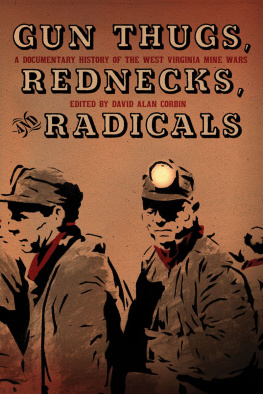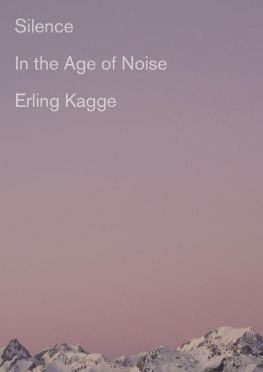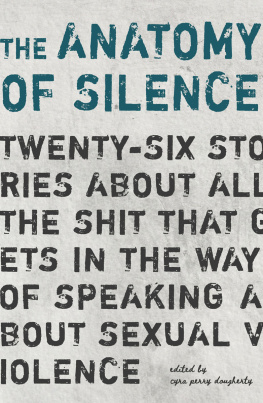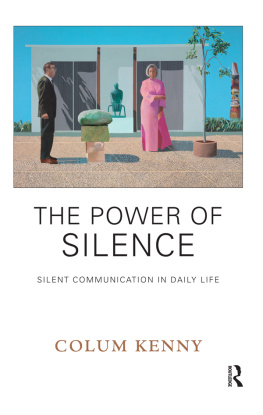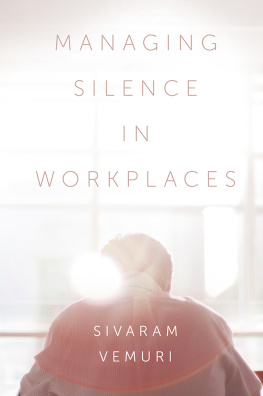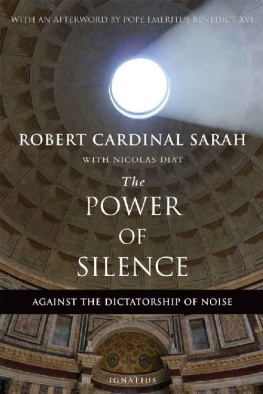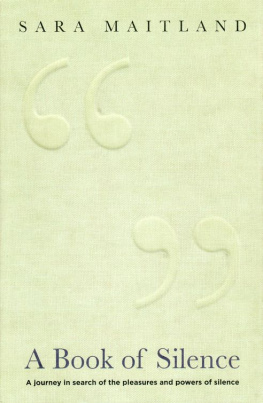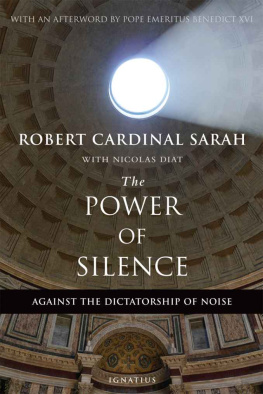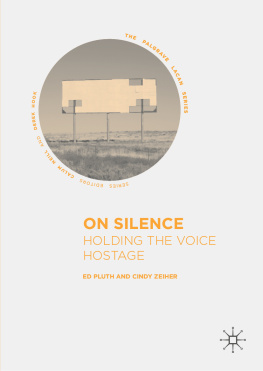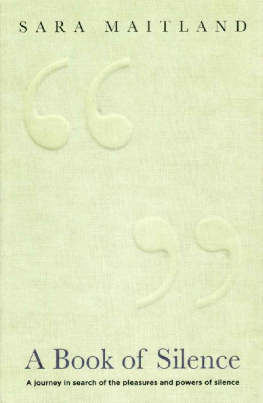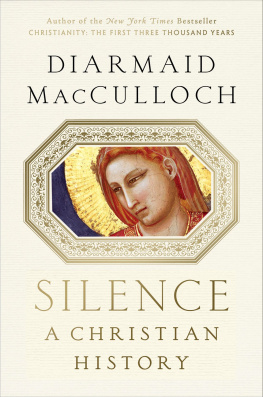Contents
Guide
Pages

A History of Silence
From the Renaissance to the Present Day
Alain Corbin
Translated by Jean Birrell
polity
First published in French as Histoire du silence. De la Renaissance nos jours ditions Albin Michel, Paris, 2016
This English edition Polity Press, 2018
Polity Press
65 Bridge Street
Cambridge CB2 1UR, UK
Polity Press
101 Station Landing
Suite 300
Medford, MA 02155, USA
All rights reserved. Except for the quotation of short passages for the purpose of criticism and review, no part of this publication may be reproduced, stored in a retrieval system or transmitted, in any form or by any means, electronic, mechanical, photocopying, recording or otherwise, without the prior permission of the publisher.
ISBN-13: 978-1-5095-1739-8
A catalogue record for this book is available from the British Library.
Library of Congress Cataloging-in-Publication Data
Names: Corbin, Alain, author.
Title: A history of silence : from the Renaissance to the present day / Alain Corbin.
Other titles: Histoire du silence. English
Description: English edition. | Medford, MA : Polity, 2018. | Includes bibliographical references and index.
Identifiers: LCCN 2017048521 (print) | LCCN 2017061303 (ebook) | ISBN 9781509517398 (Epub) | ISBN 9781509517350 (hardback) | ISBN 9781509517367 (pbk.)
Subjects: LCSH: Silence (Philosophy) | Silence--Religious aspects. | Silence--Psychological aspects. | Meditation.
Classification: LCC BJ1499.S5 (ebook) | LCC BJ1499.S5 C5813 2018 (print) | DDC 204/.47--dc23
LC record available at https://lccn.loc.gov/2017048521
The publisher has used its best endeavours to ensure that the URLs for external websites referred to in this book are correct and active at the time of going to press. However, the publisher has no responsibility for the websites and can make no guarantee that a site will remain live or that the content is or will remain appropriate.
Every effort has been made to trace all copyright holders, but if any have been inadvertently overlooked the publisher will be pleased to include any necessary credits in any subsequent reprint or edition.
For further information on Polity, visit our website: politybooks.com
Acknowledgements
I would like to thank Fabrice dAlmeida for his careful editing of the final version of this book and Sylvie le Dantec for her help with the preparation of the manuscript.
In silence there is always something unexpected, a beauty that catches you unawares, a tonality to be savoured with the finesse of a gourmet, an exquisite repose... never automatic, it happens as if impelled by some inner force. Silence descends... it comes softly and silkily.
Jean-Michel Delacompte
Petit loge des amoureux du silence
Prelude
Silence is not simply the absence of noise. We have almost forgotten what it is. Sound cues have changed their nature, become weaker and lost religious significance. The fear, even dread, caused by silence has intensified.
In the past, the people of the West savoured the depth and the qualities of silence. They saw it as the precondition for contemplation, for introspection, for meditation, for prayer, for reverie and for creation; above all, they saw it as that inner space from which speech came. They scrutinized its social tactics. For them, painting was silent speech.
The intimacy of places, that of the bedroom and its furniture, like that of the house, was bound up with silence. With the rise of the sensitive soul in the eighteenth century, and inspired by the cult of the sublime, people began to appreciate the many different silences of the desert and to listen to those of the mountains, the sea and the countryside.
Silence testified to the intensity of a love affair and seemed a precondition for union. It foretold the lasting nature of the emotion. The life of the invalid, the proximity of death and the presence of the tomb gave rise to a range of silences, which survive today only in vestigial form.
What better way could there be to experience them than to immerse ourselves in quotations from some of the many authors who have embarked on a veritable aesthetic quest? Reading them, we put our own sensibility to the test. History has too often claimed to explain. When it tackles the world of the emotions, it must also and primarily make people feel, especially when the mental worlds have disappeared. This makes a large number of revealing quotations indispensable. They alone can enable the reader to understand how people experienced silence in the past.
It is difficult to be silent today, which prevents us from listening to the inner speech that calms and soothes. Society enjoins us to accept noise in order to be part of the whole, rather than to listen to ourselves. Thus the very structure of the individual is modified.
True, a few solitary walkers, artists and writers, practitioners of meditation, those who have withdrawn to a monastery, a few women who visit graves and, above all, lovers who gaze wordlessly at each other are in search of silence and remain sensitive to its qualities. But they are like travellers washed up on what will soon be a desert island, whose shores are wearing away.
The main culprit is not, however, as might be thought, an intensification of the general noisiness of urban life. Thanks to activists, legislators, hygienists and decibelmeasuring technicians, city noise is now different but probably no more deafening than in the nineteenth century. What is new is hyper-mediatization and permanent connectivity and, in consequence, the incessant flow of words that is thrust on people and which makes them dread silence.
My evocation in this book of the silence of the past and of how people searched for it, and of the qualities, disciplines, tactics, richness and power of the speech of silence, may help us to relearn how to be silent, that is, to be ourselves.
Silence and the Intimacy of Places
There are specific places where silence makes its subtle omnipresence felt, where it can be more easily heard, where it may appear as a sweet, soft, continuous and anonymous sound; places to which the advice of the poet Valry applies: Listen to this delicate sound which is continuous, and which is silence. Listen to what you hear when nothing makes itself heard; this noise blankets everything, this sand of silence... Now nothing. This nothing is huge in the ears. It is not only thought and ideas that are affected; behaviour and decisions are also subject to its strong influence.
Among the places where silence particularly makes itself felt are the house, with its rooms, hallways and bedrooms, and all the objects that furnish it, but also certain specific buildings, such as churches, libraries, castles and prisons. I shall begin by quoting examples of what was said of these places in the nineteenth and twentieth centuries, a time when discussion of the silence of intimate places intensified. I will reserve for later the silence that is associated with contemplation and interiority, and is a precondition for meditation, prayer and listening to the word of God.
There are houses that breathe silence, where it seems to permeate the walls. This has been powerfully conveyed in our own day by the paintings of Edward Hopper. It is equally the case with Quesnay, the house of the married priest described by Barbey dAurevilly: it was in the silence of this house where silence had always held such sway that the hero, Nel de Nhou, awaiting the return of Sombreval, watched over Calixte.


